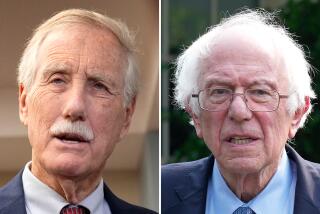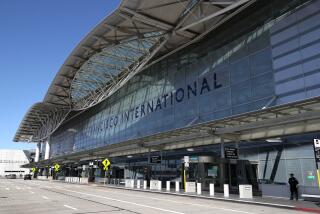For Feinstein, April Is the Cruelest Month
- Share via
It turns out the little buggers were hiding in the air ducts of a Senate Foreign Relations subcommittee room. Microscopic bits of pollen lying in wait. They made their presence known while Sen. Dianne Feinstein of California, an otherwise healthy specimen at 63, was asking questions and her airway began to constrict. She excused herself, coughing, then bolted for the anteroom, where she nearly conked out.
Paramedics were called. Some quick-thinking staffer ran one floor up to the office of Sen. Bill Frist, a Tennessee Republican and the only sitting member of Congress who is a doctor. He borrowed a stethoscope and listened to Feinstein’s chest. By then her breathing was normal again. It was all pretty scary until the next morning, when another doctor diagnosed the problem:
Spring.
*
In Los Angeles, it’s just another season. Around here, it’s a celebration. The cherry trees explode in breathtaking blossoms at Thomas Jefferson’s bronze feet. The daffodils erupt along the George Washington Parkway. The sun shines brilliantly over the Potomac.
And about half of the population starts wheezing like an accordion.
This is a particularly difficult time for transplanted Californians who never had a sinus problem in all their years in Los Angeles. Yes, they were sucking up the worst smog in the land--not to mention dust stirred up by the occasional Santa Ana. But they were not living on a spruced-up swamp with 20 species of oak trees that shoot pollen into the air for four to five weeks. Not to mention ragweed, grass and a variety of plants alien to the West.
About 40 million Americans suffer from allergies, and although every city has its pollen, Washington is one of the worst. They call it “The Sneezin’ Season.” Tree pollen starts to fly in early March, leaving a green dust on car windows. Grass pollen kicks in from April to mid-July. The city gets a break until mid-August, when the weed pollen starts, along with the humidity, which offers a lovely environment for mold. Sunny, mild days are the worst, a cruel hoax, considering those are the ones everybody waits for after a winter of freezing rain and snow.
Allergic rhinitis, the fancy term for nasal allergies, knows no political rank, reducing men big and small to an eye-watering, mucus-snarfing, mouth-breathing lot.
Feinstein is not the only one who suffers. Phones at the White House are answered, “Ha-doh?” Former General Services Administrator Roger Johnson walked around with an inhaler in his pocket until he moved back home to Laguna Beach. President Clinton’s eyes puff up and his voice sounds funny; he looks like he hasn’t had enough sleep. Practically the entire staff serving Oceanside Republican Ron Packard subsists on Sudafed and aspirin.
“Your eyes get swollen and itch. You get the most incredible headache. The whole runny nose thing happens. It just kills you,” said Nora Bomar, who used to work for Packard. “This never happened in California.”
About 7.5 million tourists flock to the Capitol each year. Type-A residents secretly hate the visiting crowds, who block the escalators by standing two abreast and clog up the Metro. They need only smile sweetly and leave revenge to the flora and fauna.
“The problem is, visitors come from different parts of the country, and they are assaulted by different types of pollen here,” said a staff member at the office of the House attending physician, where visitors steadily stream in believing they are dying. “Sometimes it overpowers them. They think it’s a heart condition.”
*
It’s always been like this. Our forefathers probably suffered miserably from hay fever, historians say, but did not know what to call it. Jefferson is said to have looked out from the White House at yellow vapors lumbering over the swamp that is now the Ellipse and remarked: “I know they carry death.”
Franklin Delano Roosevelt, whose health problems were never fully disclosed to an adoring public, suffered so terribly from hay fever that he sometimes felt he was suffocating. His personal secretary, Missy LeHand, and one of his principal advisors, Harry Hopkins, were similarly afflicted. They all carried nose drops.
“It’s too obnoxious to print, but FDR had a pump that he put up his nostrils several times a day,” said presidential historian William Seale. “In the morning, he would write his name in the dust on his desk. It was analyzed by the Department of Agriculture. They decided it had come all the way from the Midwest, from the Dust Bowl.”
When Clinton, a chronic allergy sufferer, was elected in 1992, several well-wishers offered him tips on how to live in Washington and keep breathing. He began by firing a White House physician who delayed giving him his allergy shot.
Sometimes it gets so bad that people with asthma or other respiratory problems actually collapse, a la Feinstein, who doctors say suffered a “bronchial spasm” aggravated by all the gunk in the air.
This, in essence, means the two-term senator and former mayor of San Francisco is technically allergic to Washington--a possible factor to weigh as she tries to make up her mind about whether to run for governor in 1998.
But a move to Sacramento might offer little relief. It, too, is a sump of allergies. It seems capital cities make a lot of people sick. Perhaps this is because they tend to be built on rivers.
Then again, maybe it’s just all the hot air.
More to Read
Sign up for Essential California
The most important California stories and recommendations in your inbox every morning.
You may occasionally receive promotional content from the Los Angeles Times.










